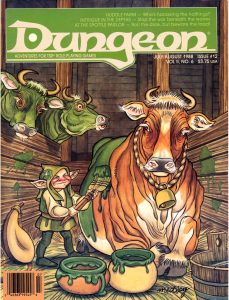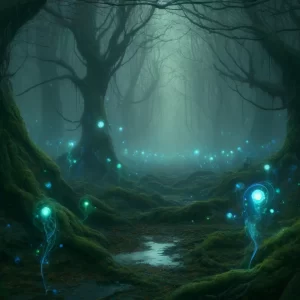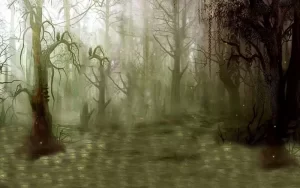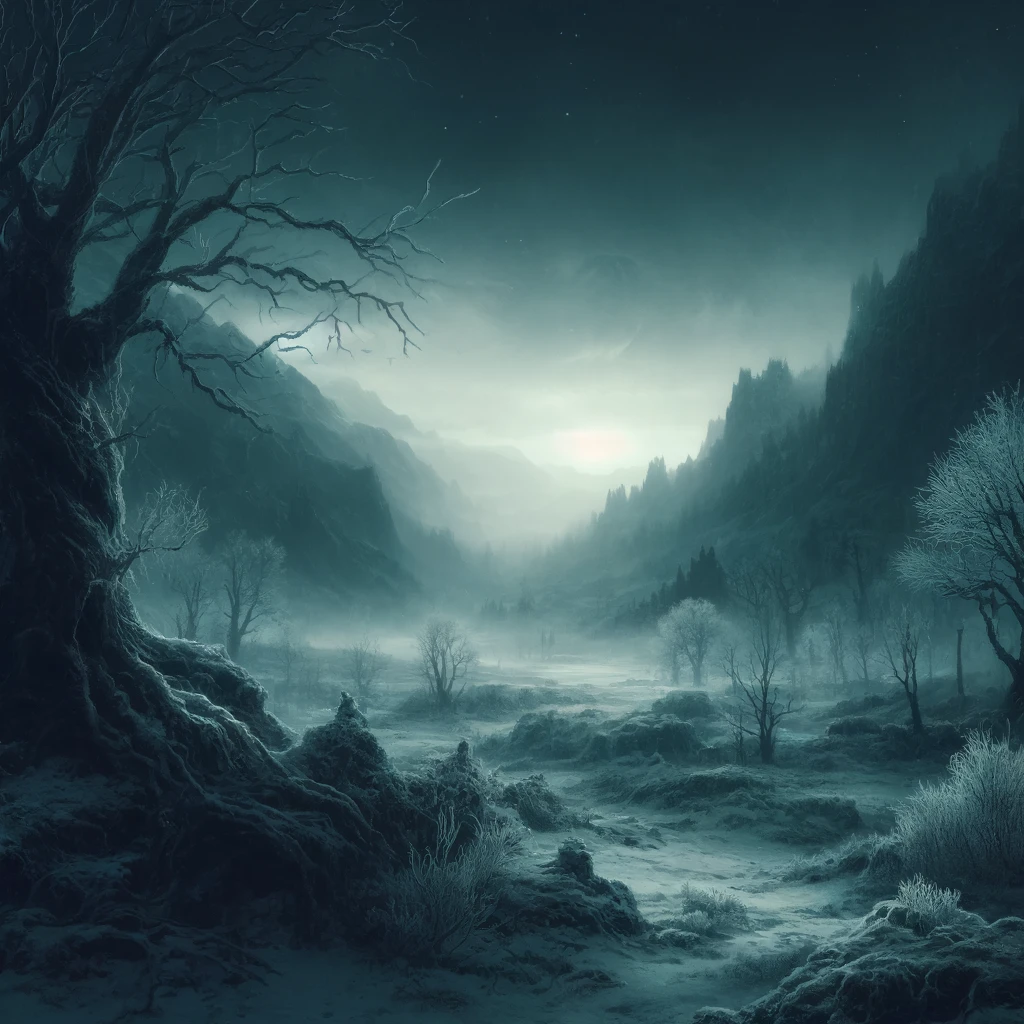
In the shadowy realms of Norse mythology, beneath the roots of the world-tree Yggdrasil, lies Hel, a kingdom as chilling as it is ancient, ruled by a figure equally shrouded in mystery. Hel, the land, is a domain not of fire and brimstone but of eerie silence and impenetrable fog, where the dead whisper of old secrets and the chill seeps into the soul.
Deep within the icy expanse of Niflheim, one of the Nine Worlds of Norse mythology, lies Hel, a realm as grim and cold as the fates it houses. This shadowy domain, perpetually shrouded in mists and frost, is the final resting place for those who pass from life due to illness, old age, or other less than glorious ends. Dark and foreboding, Hel's landscape is a stark tableau of ice and shadows, a chilling reminder of its detachment from the valor celebrated in Valhalla.
At the entrance stands Garm, a monstrous hound whose fearsome presence guards the realm. Within this desolate world, the air carries the scent of damp earth mingled with the decay of fallen leaves, underscored by a persistent, bone-chilling frost. This combination creates a sensory experience of solitude and eternal winter, echoing the cold fate of its inhabitants.
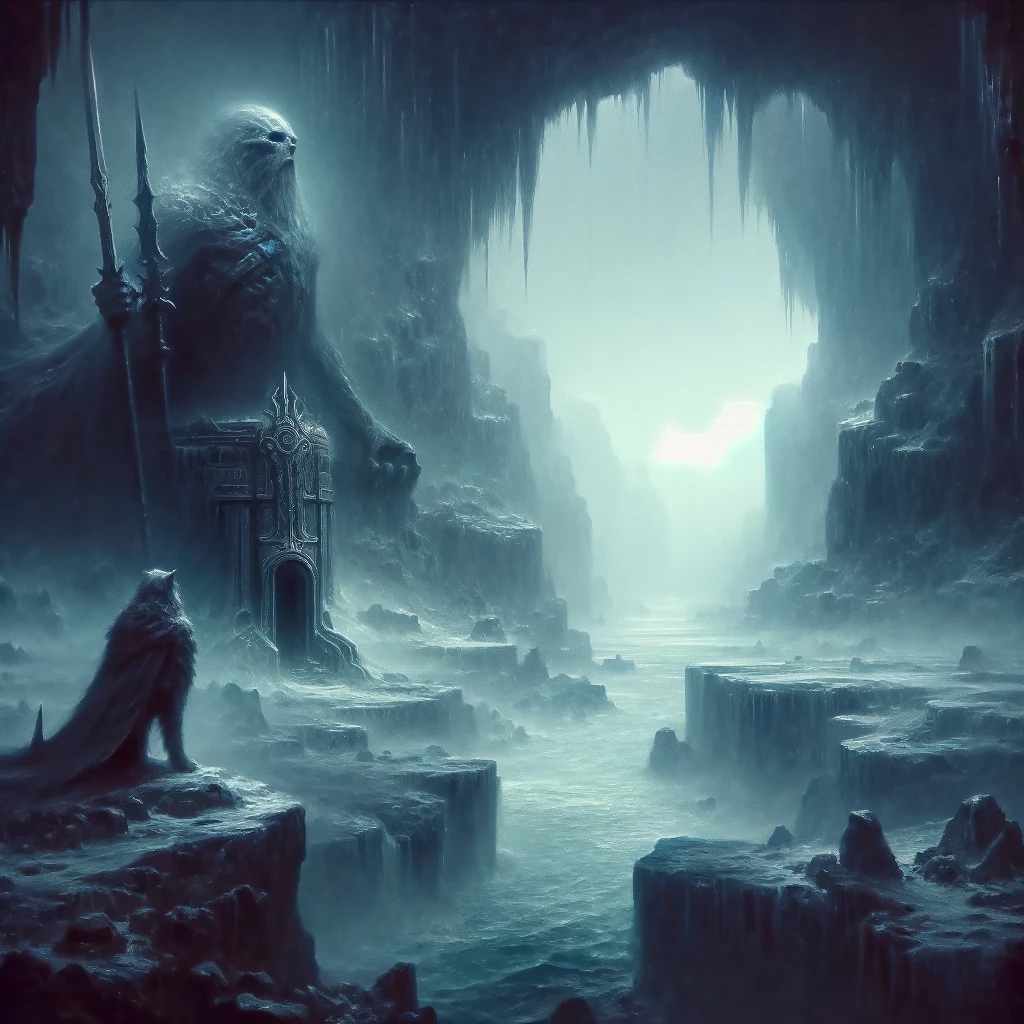
At the heart of this spectral landscape stands Hel, the goddess, daughter of the trickster god Loki and the giantess Angrboda. Half of her visage is the picture of haunting beauty, reminiscent of her Aesir lineage; the other, a grotesque and deathly mask reflecting the decay of the corpses over which she reigns. This duality captures the very essence of her domain: a place between the worlds of the living and the dead, where beauty intermingles with despair.
Hel, the goddess who rules the somber realm of the same name, embodies the stark dichotomy of life and death. She is strikingly depicted with a dual visage: one half of her face and body radiates with the beauty and vitality of the living, while the other half presents a decayed, skeletal form - a haunting illustration of her dominion over the afterlife. Her presence instills a profound sense of dread and unease, making tangible the chilling reality of death. Imagining her scent, one might perceive a blend of the cold, sterile aroma reminiscent of a grave, interwoven with the deep, earthy odors of the underworld. This sensory mix not only defines her as the embodiment of death but also as a perpetual reminder of the mortal cycle of decay and rebirth.
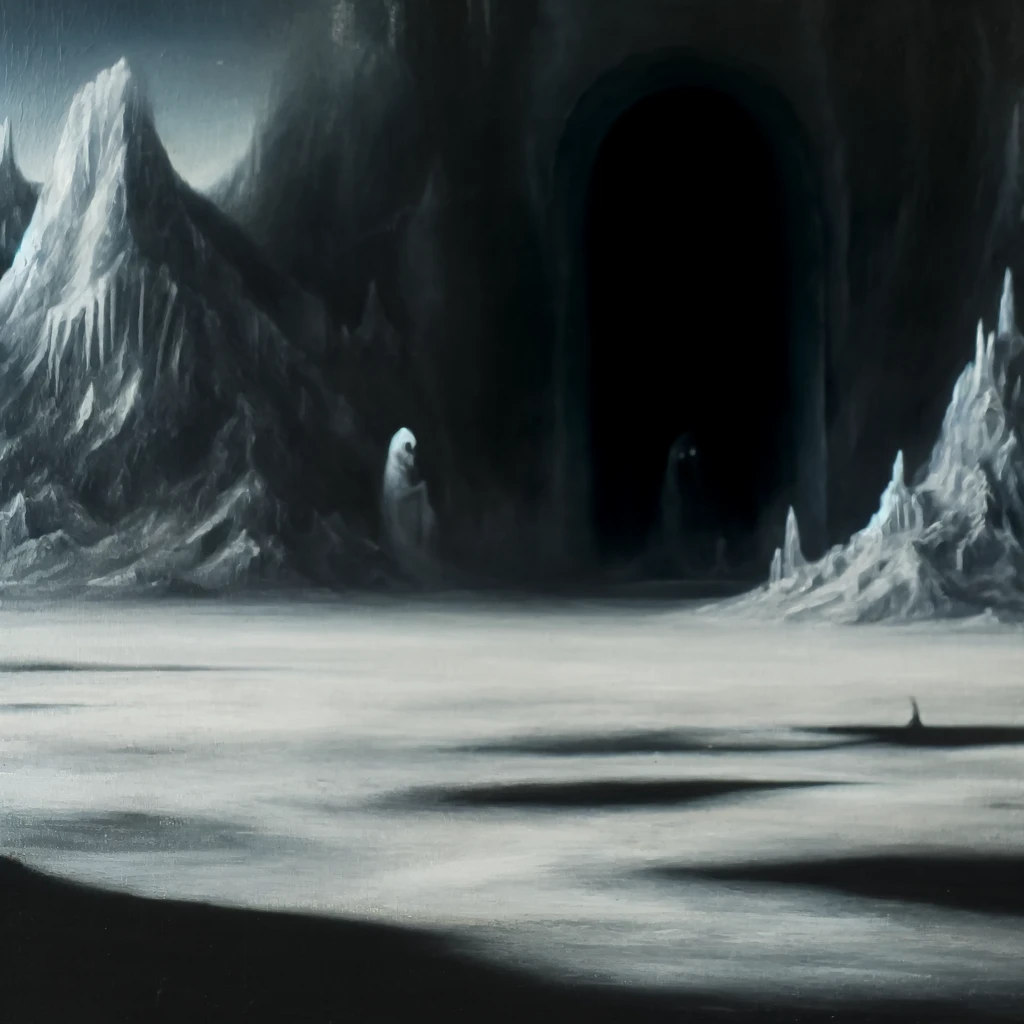
Her hall, Éljúðnir, looms large, its sprawling architecture a monument to the somber reality of death. It is here that those who did not die a warrior's death come to rest, far from the heroic songs and valiant battles of Valhalla. In this realm of shadows, Hel governs with a cold and fair hand, her judgments as inevitable as the fate that brings the dead to her doors.
Within the dimly lit confines of Éljúðnir, the air is thick with silent whispers and the echoes of footsteps that tread softly over stone. The hall, stark and devoid of the warmth of the living world, is adorned with symbols that reflect the solemn nature of Hel's rule-runic carvings that speak of fate and destiny, interwoven with scenes from the lives those who dwell here once led. This is not a place of torment, but rather a quiet sanctuary where the dead are afforded the dignity of rest, reflecting the compassionate aspect of Hel's rulership.
Outside the boundaries of Éljúðnir, the landscape of Hel stretches vast and bleak. Gnarled trees devoid of leaves cast eerie shadows that dance in the faint, ghostly light, and the ground is perpetually frosted, crunching softly underfoot. Here, the River Gjöll flows with a quiet murmur, its waters cold and somber, serving as the final barrier between the world of the living and the realm of the dead. This river, crossed only by the bridge Gjallarbrú, which is guarded by the maiden Modgud, marks the boundary of Hel's dominion-a liminal space where the chill of death meets the memories of life.
Mysterious are the ways of Hel, whose motives and thoughts are as hidden as the mist-shrouded pathways of her dark abode. Legends whisper of her power and her wisdom, of her dealings with the greatest gods and heroes of Norse myths, always reminding those who listen of the fine line between life and death, between despair and beauty.
The enigma of Hel extends beyond her haunting appearance and into the depths of her actions and intentions. She interacts with gods and mortals alike, her decisions woven into the fabric of countless sagas, where she often emerges as a pivotal figure in the cosmic dramas of Norse mythology. Despite her fearsome reputation, Hel's role is complex, embodying not just an end but a necessary transition, reflecting the Norse belief in the cyclical nature of existence. This duality is mirrored in every mist-filled corner of her kingdom, where despair coexists with a stark, poignant beauty that can only be appreciated by those who have seen beyond the veil of life.
As the keeper of secrets and the silent witness to all that passes through her gates, Hel commands a unique type of respect and fear among the denizens of the nine worlds. Her interactions are marked by a deep, unyielding fairness, serving the cosmic balance that governs both gods and mortals. Her influence is subtle yet profound, permeating the tales of heroes who venture near her realm or dare to challenge her authority. Through these tales, Hel teaches the living about the fragility of life and the inevitability of death, urging them to find beauty even in the darkest of times.
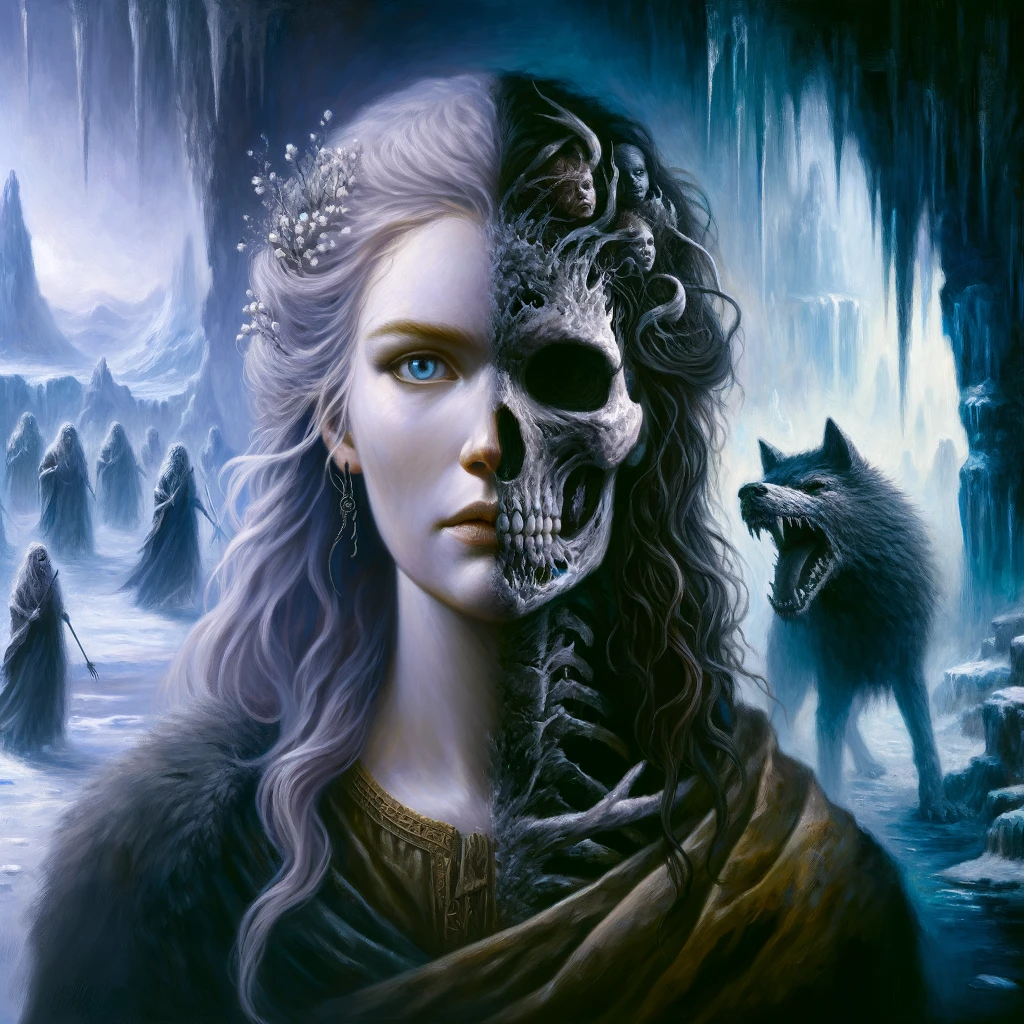
Hel, the realm in Norse mythology, is an intricate world of cold, shadows, and spectral silence, distinct from the fiery chaos often depicted in other underworlds. It is situated deep within Niflheim, one of the Nine Worlds, a place synonymous with mist and cold, serving as the final resting place for those who die of illness, old age, or without the glory of battle. Unlike the valorous halls of Valhalla, Hel's domain offers a more somber reflection on mortality, where the deceased find neither punishment nor reward but a quiet continuation of existence in the grey expanse.
The landscape of Hel is often depicted as foreboding and desolate, a realm enveloped in eternal twilight. The ground is frozen, covered in hoarfrost, with the barren trees and the faint, misty light creating an atmosphere of perpetual dusk. It is here that the stark architecture of Éljúðnir stands, Hel's expansive hall, a monument to the inevitability of death and the equalizing nature of time, where all are welcomed without distinction.
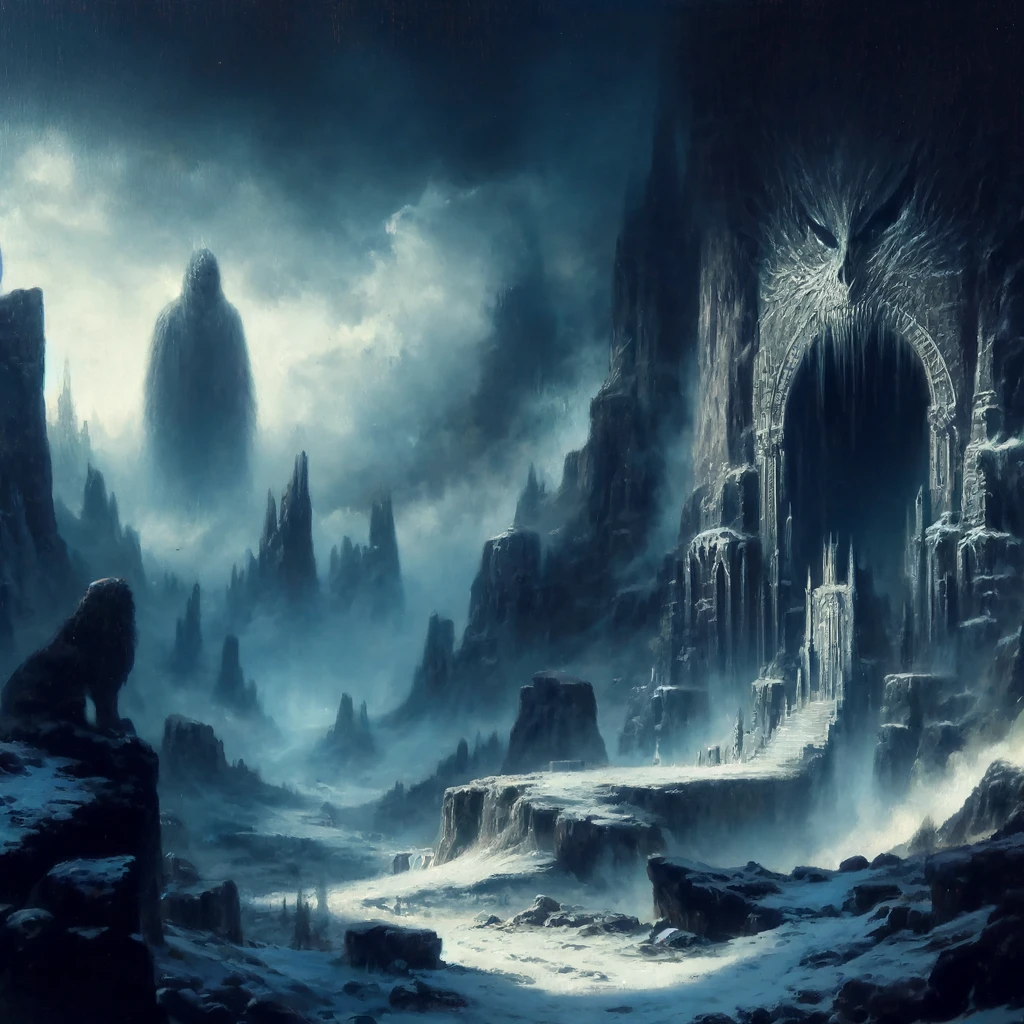
Guarding the entrance to this somber kingdom is Garm, a monstrous hound with bloodied jaws, who stands watch at the gates of Hel. His presence is as formidable as the iron-bound gates he protects, deterring those who might foolishly attempt to leave or enter without the goddess's permission. The River Gjöll, another significant landmark within Hel, flows nearby, its waters dark and chilling, mirroring the cold that pervades the realm. The only crossing is the Gjallarbrú, a bridge watched over by the maiden Modgud, who speaks only to those souls brave enough to make the journey to the afterlife.
Inside Hel, the air is tinged with the scent of damp earth and decay, a reminder of the life that once was. This realm, while haunting, is not without a certain melancholic beauty, evoking a deep reflection on the cycles of life and death. It is a place where the dead wander, lost in their thoughts, their whispers adding to the somber quietude that blankets the landscape, a stark contrast to the lively feasts of Valhalla, yet peaceful in its own solemn way.



